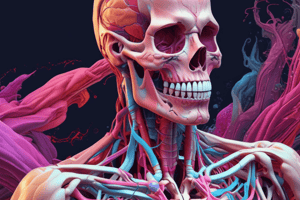Podcast
Questions and Answers
Jaką rolę pełnią mięśnie w organizmie człowieka?
Jaką rolę pełnią mięśnie w organizmie człowieka?
- Pozwalają na przemieszczanie się, utrzymanie postawy i generowanie ciepła. (correct)
- Usuwają produkty przemiany materii z organizmu.
- Transportują tlen i składniki odżywcze przez organizm.
- Pomagają w trawieniu pokarmu.
Który system odpowiada za regulację różnych funkcji ciała za pomocą wydzielania hormonów?
Który system odpowiada za regulację różnych funkcji ciała za pomocą wydzielania hormonów?
- Układ nerwowy
- Układ oddechowy
- Układ hormonalny (correct)
- Układ pokarmowy
Jakie funkcje pełni układ oddechowy w organizmie człowieka?
Jakie funkcje pełni układ oddechowy w organizmie człowieka?
- Wchłania dwutlenek węgla i wydziela tlen. (correct)
- Rozkłada pokarm na składniki odżywcze.
- Wytwarza ciepło poprzez skurcze mięśni.
- Wydala produkty przemiany materii w postaci moczu.
Jaki jest główny cel układu pokarmowego?
Jaki jest główny cel układu pokarmowego?
Co to jest homeostaza?
Co to jest homeostaza?
Jakie są dwa główne typy ludzkich komórek?
Jakie są dwa główne typy ludzkich komórek?
Które tkanki wykonują czynności związane z ruchem w organizmie?
Które tkanki wykonują czynności związane z ruchem w organizmie?
Co odróżnia tkankę nabłonkową od tkanki łącznotkankowej?
Co odróżnia tkankę nabłonkową od tkanki łącznotkankowej?
Jakie są przykłady narządów w ludzkim ciele?
Jakie są przykłady narządów w ludzkim ciele?
Które komórki nie posiadają jądra ani organelli otoczonych błoną?
Które komórki nie posiadają jądra ani organelli otoczonych błoną?
Study Notes
Exploring the Human Body: A Journey through Anatomy
Imagine unraveling the intricate and wondrous complexity of life itself - this is the realm of human anatomy. From the tiniest of cells to the towering skeletal frame, our bodies are an incredible spectacle of form and function. Let's embark on a journey through the fundamentals of human anatomy, taking a closer look at the systems and structures that make up this magnificent organism.
Cells: The Building Blocks
At the core of every human, we find cells - the smallest units of life. They come in a variety of shapes and sizes, each performing specific functions. The two primary types of human cells are eukaryotic and prokaryotic. Eukaryotic cells, found in all multicellular organisms, contain a nucleus and membrane-bound organelles, while prokaryotic cells, like bacteria, lack a nucleus and membrane-bound organelles.
Tissues: Groups of Specialized Cells
Groups of similar cells combine to form tissues, which carry out specific functions. There are four main types of tissues: epithelial, connective, muscle, and nervous. For example, epithelial tissue covers external and internal surfaces, while connective tissue binds and supports other tissues.
Organs: Functional Units
Organs, such as the heart, liver, and kidney, are made up of multiple types of tissues working together to perform their specialized functions. For example, the heart consists of cardiac muscle tissue and valves made from connective tissue, which together enable it to pump blood throughout the body.
Systems: Diverse Functions
The human body is organized into 11 systems, each responsible for a unique set of functions. Some of the major systems include:
- Skeletal system: This system provides structural support, protection, and attachment points for muscles.
- Muscular system: Muscles allow us to move, maintain posture, and generate heat.
- Nervous system: This system coordinates and controls the body's activities, sending and receiving messages through neurons.
- Digestive system: Digestion breaks down food into nutrients, which are absorbed into the bloodstream.
- Respiratory system: This system takes in oxygen and expels carbon dioxide through the process of breathing.
- Circulatory system: The heart and blood vessels transport oxygen, nutrients, and waste products throughout the body.
- Urinary system: This system removes waste products from the body in the form of urine.
- Lymphatic system: This system supports the immune system, transports fats, and helps maintain fluid balance in the body.
- Endocrine system: This system involves glands that secrete hormones, which regulate various body functions.
- Reproductive system: This system allows for the creation of new life and sexual reproduction.
- Integumentary system: This system protects the body from physical damage, regulates body temperature, and produces vitamin D.
Homeostasis: The Balance of Life
The human body maintains a delicate balance of conditions essential for life - this process is known as homeostasis. For instance, the body tightly controls blood glucose levels, body temperature, and blood pressure to ensure proper functioning.
In conclusion, the human body is an incredible machine, with each part working in harmony to sustain life. Exploring anatomy helps us to better understand the intricate interplay between the various systems and structures, allowing us to appreciate the beauty and complexity of our own existence. So, the next time you look in the mirror, remember that you are gazing upon a marvel of evolution, a testament to the resilience and wonders of life itself.
Studying That Suits You
Use AI to generate personalized quizzes and flashcards to suit your learning preferences.
Description
Embark on a journey through the fundamentals of human anatomy, exploring the intricate systems and structures that make up the human body. Learn about cells, tissues, organs, and the 11 major systems, each responsible for unique functions. Dive into the concept of homeostasis and how the body maintains a delicate balance of conditions essential for life.





